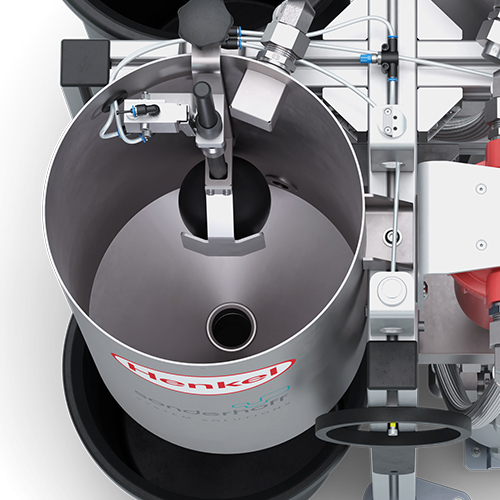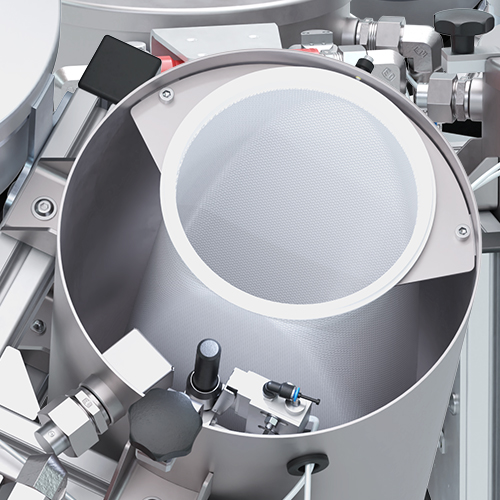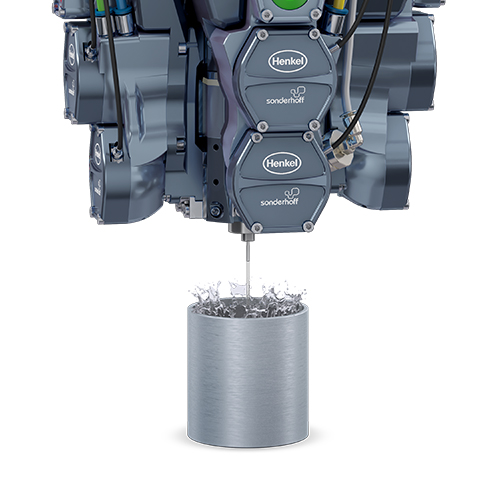The new Sonderhoff Rinsing Water Recylcing System
Sustainability is a crucial part of Henkel‘s corporate strategy. For this reason, attention is paid to offering our customers sustainable solutions not only in the development of adhesives and sealants, but also in the development of mixing and dispensing machines.
Sonderhoff mixing and dispensing machines are sustainable because they use Formed-In-Place-(Foam-Gasket) / FIP(FG) technology to apply only as much material as necessary. In addition, the mixing chamber is cleaned of material build-up using an ecological high-pressure water rinsing system. Compared to conventional solvent rinsing, only tap water is used. Solvents, on the other hand, are not ecologically degradable and cause costs for additional purchases and disposal.

With the newly developed rinsing water recycling system, the rinse/process water for high-pressure water rinsing is cleaned in a two-stage filtering process.
The filtered rinse water is then available as process water for several further rinsing cycles.
This significantly reduces the freshwater consumption of the high-pressure water rinsing system as well as the amount of water that needs to be disposed chargeable to the sewage system.
The new rinse water recycling system is set up in the traversing area of the mixing head of the dosing machine and can be retrofitted and connected by the user for the mixing and dosing systems with the linear robots LR-HD, LR-HE plus or 6-axis robots at any time as an option (this does not apply to the 3E and SMART systems).
The cost savings achieved by using the rinsing water recycling system enable the investment costs to be amortized after approx. 4.9 years and therefore a return on investment.
The process sequence of the rinsing water recycling system
The mixing chamber in the mixing head of the DM 50x dosing machine is cleaned using ecological high-pressure water rinsing (HDW), which uses approx. 2 x 200 ml of tap water per cleaning cycle, depending on the size of the mixing chamber and the material used. This is done by injecting water into the mixing chamber at an adjustable high pressure of between 80 and 140 bar, so that the surfaces in the mixing cham- ber are mechanically cleaned of material build-up.

The process sequence of the rinse water recycling system for cleaning the process water for high-pressure water rinsing begins with filling the 25 litres process water tank (1) with tap water plus glycol 4 %. From there, the water is drawn in and the water used for this high-pressure cleaning is supplied to the mixing chamber via a hose.
The rinsing water used for this high-pressure cleaning is dispensed through the mixing head nozzle into the rinsing water tank (2). There, coarse impurities from the rinsing process of the mixing chamber are passed through a 50 µm coarse filter (3) in the first filter stage and filtered out.
When the water level in the rinse water tank (2) reaches a certain level after several rinsing processes, the roller lever valve is triggered by the integrated float and the pneumatic diaphragm pump (4) is activated.
The rinse water is then cleaned again by the second filter stage with a 5 µm fine filter cartridge (5) and pumped back into the process water tank (1).
The filtered process water is thus available for several further rinsing cycles. Depending on the number of rinsing cycles the 25 litres of fresh water in the rinse water recycling system must be changed approximately every 2 months.
If the water level in the process water tank (1) falls below a minimum level, a warning is issued via a visual and acoustic display.
 Process water tank
Process water tank
Diaphragm pump
Rinsing water tank
Coarse filter
Fine filter cartridge
Mixing head high-pressure water cleaning
Process water tank
Process water tank
Diaphragm pump
Rinsing water tank
Coarse filter
Fine filter cartridge
Mixing head high-pressure water cleaning
Process water tank

The finely filtered rinse water is pumped back into the process water tank as purified process water, where it is available for several more rinse cycles.
Process water tank

The process begins with filling of the 25 litres process water tank. From there, the water is sucked in and is supplied via a hose for the high-pressure water rinsing of the mixing chamber in the mixing head. If the water level in the process water tank falls below a minimum level, the float (B) activates the roller lever valve (A) and an audible and visual signal is emitted.
Diaphragm pump

When the water level in the rinse water tank reaches a certain level after several rinsing processes, the roller lever valve is triggered by the integrated float and the pneumatic diaphragm pump is activated.
Rinsing water tank

The rinsing water used for high-pressure cleaning is dispensed through the mixing head nozzle into the rinse water tank.
Coarse filter

Coarse impurities from the rinsing process in the mixing chamber are passed through a 50 μm coarse filter in the rinsing water tank in the first filter stage and filtered out.
Fine filter cartridge

The coarsely filtered rinsing water, activated by the membrane pump, is fed to the second filter stage and purified there with a 5 μm fine filter cartridge.
Mixing head high-pressure water cleaning

With ecological high-pressure water rinsing (HDW), the mixing chamber in the mixing head is cleaned by injecting (approx. 2 x 200 ml per cleaning cycle, depending on the size of the mixing chamber and the material used) at an adjustable high pressure. material used) at an adjustable high pressure of between 80-140 bar.
Cost savings when using the Rinsing Water Recycling System
Initial situation for the customer‘s work process:
|
Working days per year (5 days per week) |
253 |
|
Shifts per day |
2 |
|
Rinsing cycles per shift |
20 |
|
Water per rinse cycle |
400 ml |
|
Disposal costs per tonne |
800 € |
|
|
Without rinse water recycling system | With rinse water recycling system |
|
Water consumption / year |
4,048 l | 120 l |
|
Disposal costs for contaminated water (litres) / year |
3,200 € | |
|
Disposal costs for contaminated water, filter + filter cake / year |
96.00 € | |
|
Costs per fresh water litre / year |
12.15 € | 0.36 € |
|
Labour costs / year |
675 € | 180 € |
|
Filter and glycol additive purchase |
60 € | |
|
Total |
3,887.15 € | 335.36 € |
|
Savings / year (Y) |
3,550.79 €/Y |
FAQ rinsing water recycling system
What is the maximum distance between the rinse water recycling system and the high-pressure water rinsing (HDW)?
The maximum hose length: 10 m
Which robots does the rinse water recycling systemwork with?
6-axis robot, 3-axis linear robots LR-HD, LR-HE plus
Can the rinse water recycling systemcommunicate with our dosing machines or be controlled by them?
No, it is a stand-alone version without sensors or PLC connections.
For which chemicals can the rinse water recycling systembe used?
With all adhesives and sealants that are not liquid after dosing or are water-soluble (filter then does not work).
How must the rinse water recycling systembe set up?
The rinse water recycling system replaces the previous rinsing and fill shot station and must be positioned so that the rinsing and fill shot positions of the rinse water recycling system are aligned in the same way (see layout in the operating instructions).
Can the rinse water recycling systembe retrofitted to existing dosing machines?
Yes, usually for the mixing and dosing systems with 3-axis linear robots LR-HD, LR-HE plus or 6-axis robots (this does not apply to the 3E and SMART systems), provided the existing system layout offers sufficient space.
What kind of connections does the rinse water recycling systemneed?
A connection hose is only required for compressed air (max. 8 bar) and for water from the process water tank to the HDW rinsing of the dosing system (see flow diagram in the manual).
How often need the filters to be changed?
We recommend checking the coarse filter once a week. Depending on the frequency of rinsing shots, the coarse filter and the fine filter should be changed once a month on average. The rinse water and the 5µm fine filter should be changed every 2-4 months, depending on the number of rinses, and the rinse and process water tank should be cleaned.
How often does fresh water need to be topped up?
We recommend checking the water level in both tanks once a week. If the water level in he process water tank is less than half the fill level and there is hardly any water left in the rinse water tank, water must be topped up. If the If the rinse water tank is almost empty, the process water tank can be filled up to the maximum level mark.
Under what conditions can the rinse water recycling system not be used?
A: The chemicals used are water-soluble
B: Chemistry used is liquid after the rinse cycle
C: Dosing machine in 3E cell or Smart cell
D: HDW positioning at head height or above (suction capacity of the HDW is then insufficient)
Is the rinse water recycling system height-adjustable?
The rinse water recycling system itself is not height-adjustable, but the injection nozzle can be pulled out by max. 100 mm using a knurled screw, to facilitate align- ment with the mixing head. If this is not sufficient, the rinse water recycling system would have to be placed on a pedestal.
Is the rinse water recycling system mobile?
No, once it has been positioned, it should be fixed to the floor with heavy-duty anchors.
Does the water in the rinse water recycling system have to be changed?
Yes, despite the addition of glycol, algae may form in the water due to impurities or it may otherwise ‘go bad’. It is therefore advisable to change the water in the entire system 3-4 times a year so that the fine filter does not become clogged.
How do you recognize when there is not enough water in the process water tank?
The visual and audible indicators of the rinse water recycling system signal when there is not enough water in the process water tank. The visual signal turns red, and the acoustic indicator emits a whistling sound.
Can the volume of the acoustic signal for the process water tank be changed?
Yes, the volume can be adjusted using the throttle located near the acoustic signal.
